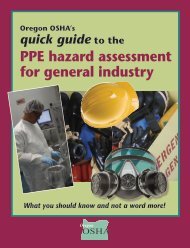Technical Manual - Section 3 (Safety Hazards)
Technical Manual - Section 3 (Safety Hazards)
Technical Manual - Section 3 (Safety Hazards)
You also want an ePaper? Increase the reach of your titles
YUMPU automatically turns print PDFs into web optimized ePapers that Google loves.
The solvent is separated from the product stream by heating,<br />
evaporation, or fractionation, and residual trace amounts are<br />
subsequently removed from the raffinate by steam stripping<br />
or vacuum flashing. Electric precipitation may be used for<br />
separation of inorganic compounds. The solvent is then<br />
regenerated to be used again in the process.<br />
The most widely used extraction solvents are phenol, furfural,<br />
and cresylic acid. Other solvents less frequently used are<br />
liquid sulfur dioxide, nitrobenzene, and 2,2' dichloroethyl<br />
ether. The selection of specific processes and chemical<br />
agents depends on the nature of the feedstock being treated,<br />
the contaminants present, and the finished product<br />
requirements.<br />
Table III:2-7. SOLVENT EXTRACTION PROCESS<br />
Feedstocks From Process Typical products.................... To<br />
Naphthas Atm. tower Treating High octane gasoline............... Treating or blending<br />
Distillates Refined Fuels.......................... Treating or blending<br />
Kerosene Spent agents............................ Treatment or recycle<br />
Figure III:2-10 Aromatics Extraction<br />
Diagrams in Figures II:2-10, 11, 12, 13, 15, and 20<br />
reproduced with the permission of Shell International<br />
Petroleum Company Limited.<br />
III:2-21
















